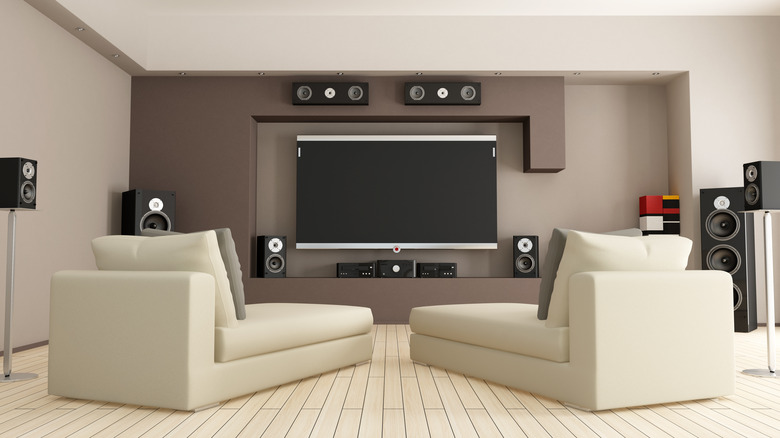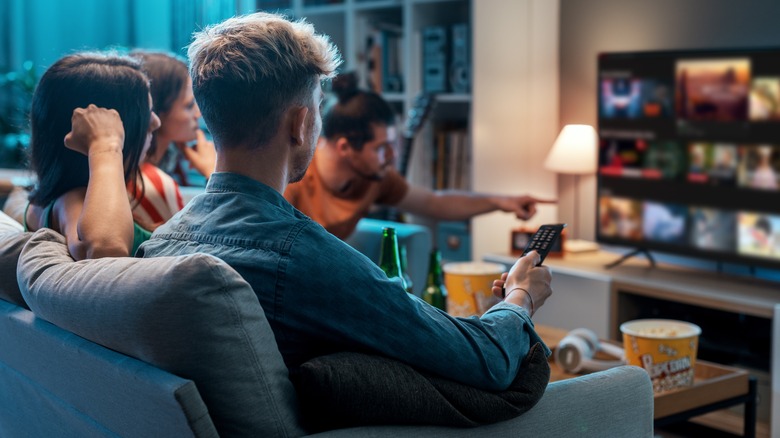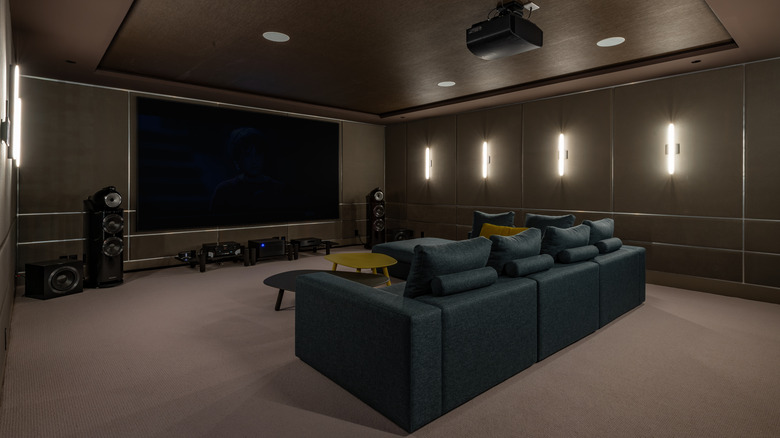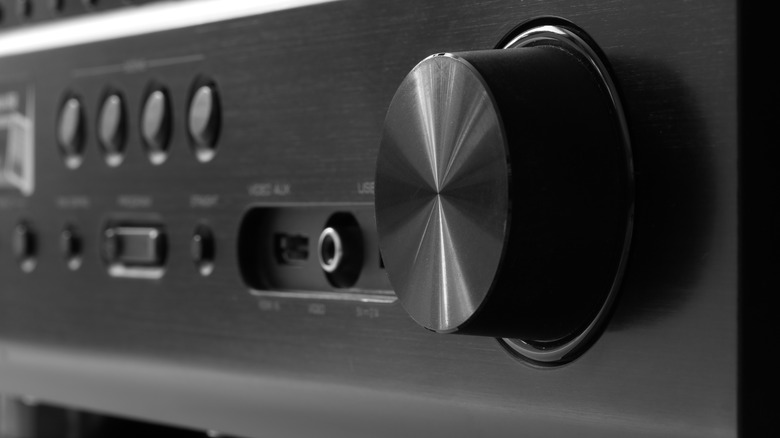How To Fine Tune Your Home Surround Sound Set Up For The Best Experience
When many of us think of the ultimate home theater setup, the visuals come to mind. We want to make sure we've invested in a top-notch projector or television to ensure the picture is crisp and the colors pop. If our budget permits, we may consider adding theater seating to the setup to give it even more authenticity. Most importantly, we want to replicate that immersive movie theater experience in the comfort of our own homes.
While all of these things are important, if you overlook the audio component of your home theater, you're going to miss out on a big part of the experience. Just think back to the last time you went to a movie theater. The music wasn't just background noise. Instead, you felt the action vibrating through your seat and the music and dialogue enveloping you from all sides, transporting you to the middle of the story.
Let's face it: No matter how high-tech your TV is, built-in speakers just don't cut it. A proper audio setup is necessary if you want to create a true cinematic experience in your home. However, even the best surround sound system isn't enough to guarantee a cinematic experience. The good news is fine-tuning your setup can change everything, turning your living room into a space that rivals the best movie theaters. And it's not just about watching movies; you'll appreciate it when playing video games and listening to your favorite tunes, too.
Acoustics and sound optimization
When we think of getting the best audio experience out of a home surround system, the speakers are the first things to come to mind. While speakers are important, your room's acoustics can make or break your audio experience. This is because after sound leaves a speaker, much of the audio we hear in a room is reflected — sound bouncing off walls, ceilings, and floors. Standing waves, bass buildup, and flutter echo are the most common acoustic issues that can distort sound quality.
Getting reflected sound under control can keep it from muddying the clarity and detail of what we're listening to. That's where acoustic treatments like diffusion panels, bass traps, and acoustic panels come in. These treatments can help manage reflections, allowing the audio from your surround sound system to reach your ears as intended, creating a more immersive and true-to-life listening experience. They also block external noises, ensuring you can hear every whisper and sound effect without outside interference.
Speaker placement is important
Once you've got the acoustics of your room under control, you should turn your attention to speaker placement. While you may be tempted to arrange your speakers wherever they fit best or look good in your space, that could compromise audio quality. Instead, if your goal is to fine-tune your home surround sound system, you'll need to place your speakers strategically to get the most out of them. Since the center speaker carries the bulk of spoken words and dialogue in a surround sound setup, they should be aligned with the TV, ideally at ear level when seated.
You should also place the left and right speakers at ear level, and they should form an equilateral triangle. Avoid putting your front speakers inside your entertainment center or bookshelves; while this may be aesthetically pleasing, it can muffle the sound and cause reflections that distort audio quality. Instead, position them slightly away from the wall and at a distance that creates a wide enough soundstage for the sound to be properly dispersed throughout the room.
In contrast, the surround speakers, which provide ambient sounds and effects, should be placed slightly above ear level to enhance the immersive experience. You have more flexibility when placing the subwoofer, which handles low-frequency effects. However, putting it in a corner can improve its output, making the bass feel more powerful.
Calibration for balanced sound
Another important step in getting the most out of your surround sound system is making sure you properly calibrate your speakers. You'll want to start with volume leveling to ensure no single speaker overpowers the others. You can do this by adjusting each speaker's volume so that they all contribute equally to the overall sound based on where the listener is sitting. You can use speaker calibration tools, including built-in receivers or external equipment, to measure and adjust the sound output. These tools use microphones to measure sound production from different locations within a room, automatically adjusting each speaker's volume, delay, and equalization settings to compensate for room acoustics and layout irregularities.
Audyssey is a common calibration system found in many AV receivers. This system can improve the listening experience by analyzing the sound from multiple listening positions and adjusting it accordingly. If you prefer manual calibration, using an SPL meter or calibration software can give you more control over the process, allowing you to make precise adjustments to speaker levels and EQ settings to achieve a more accurate soundstage.



